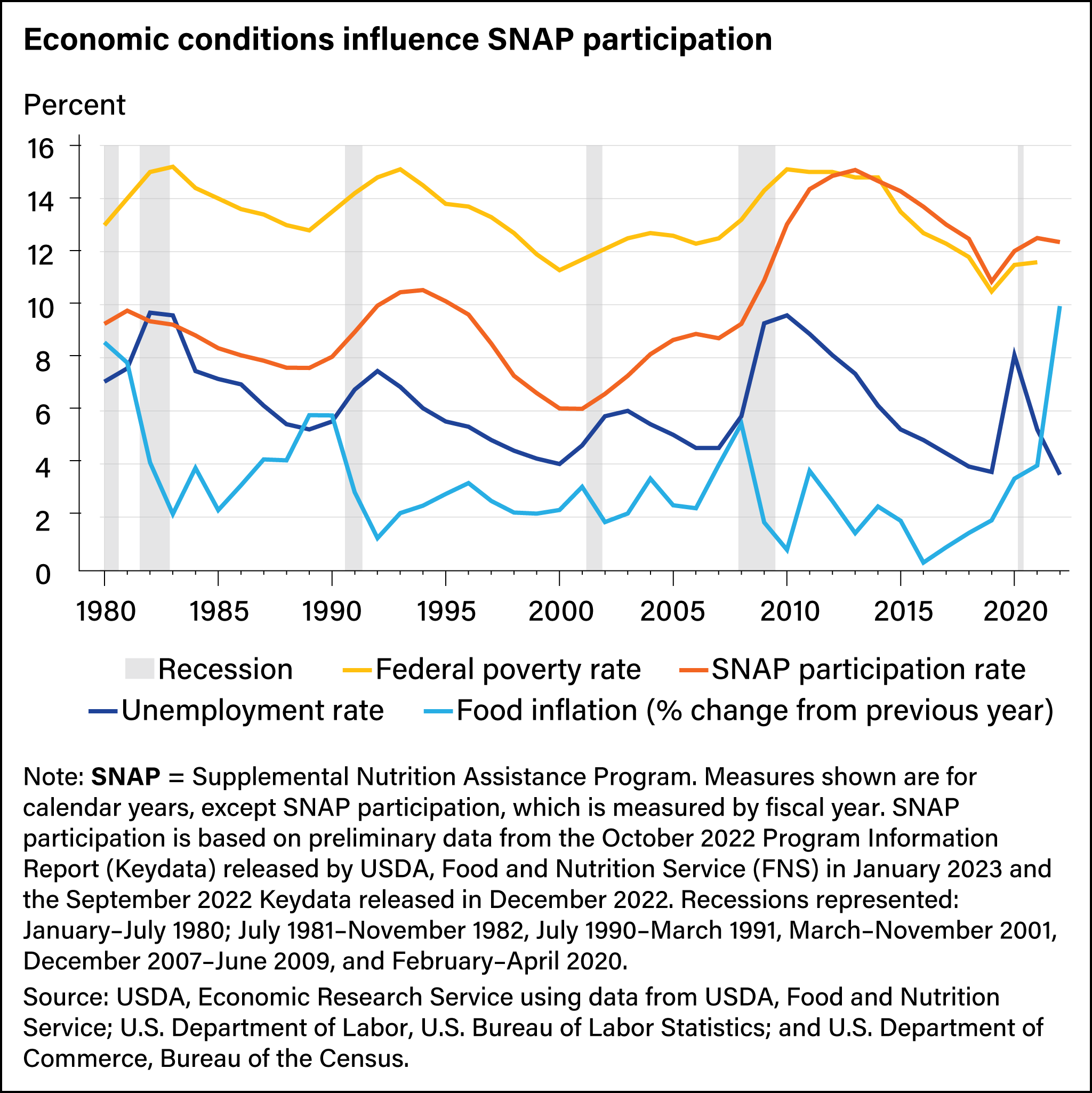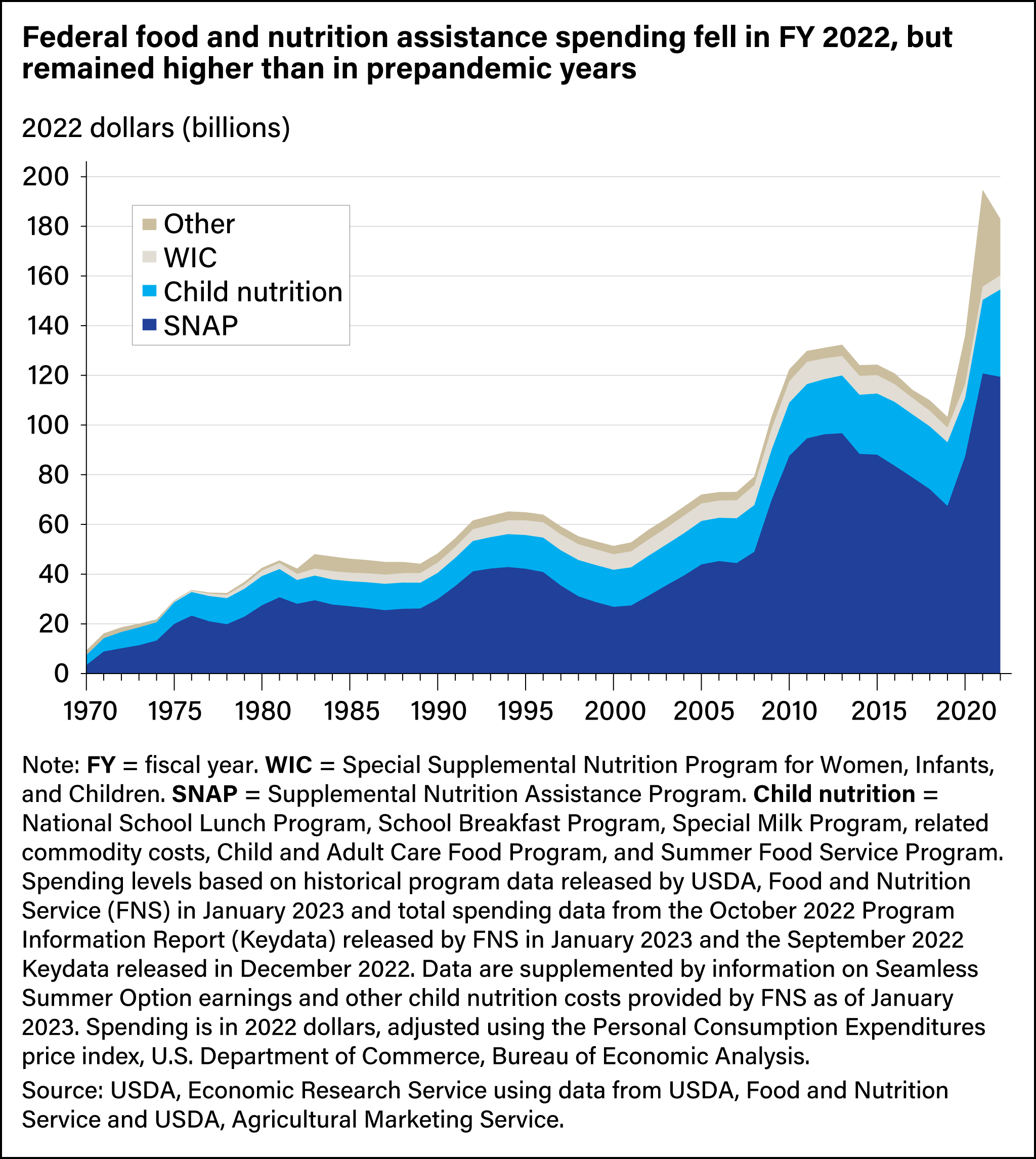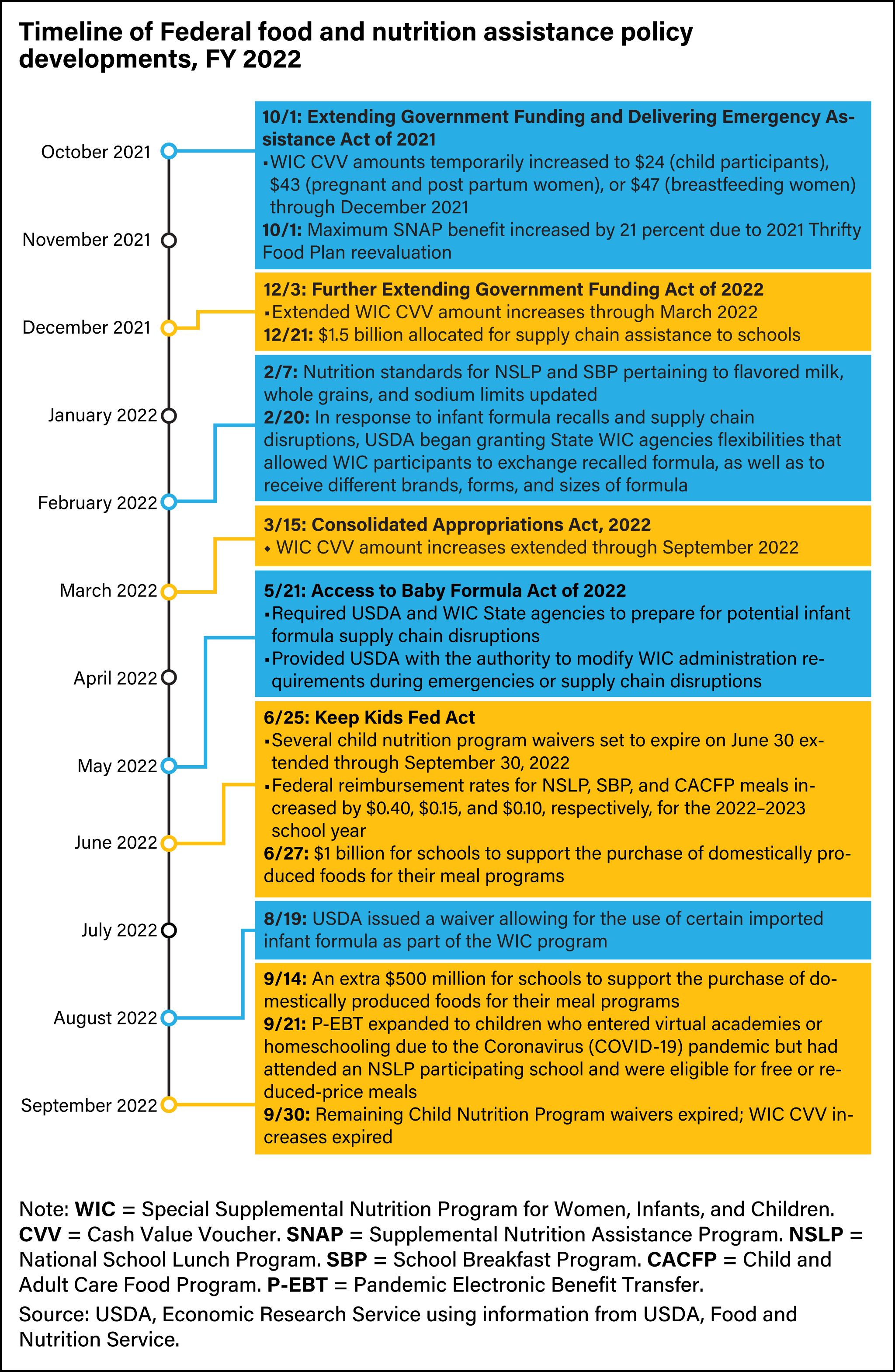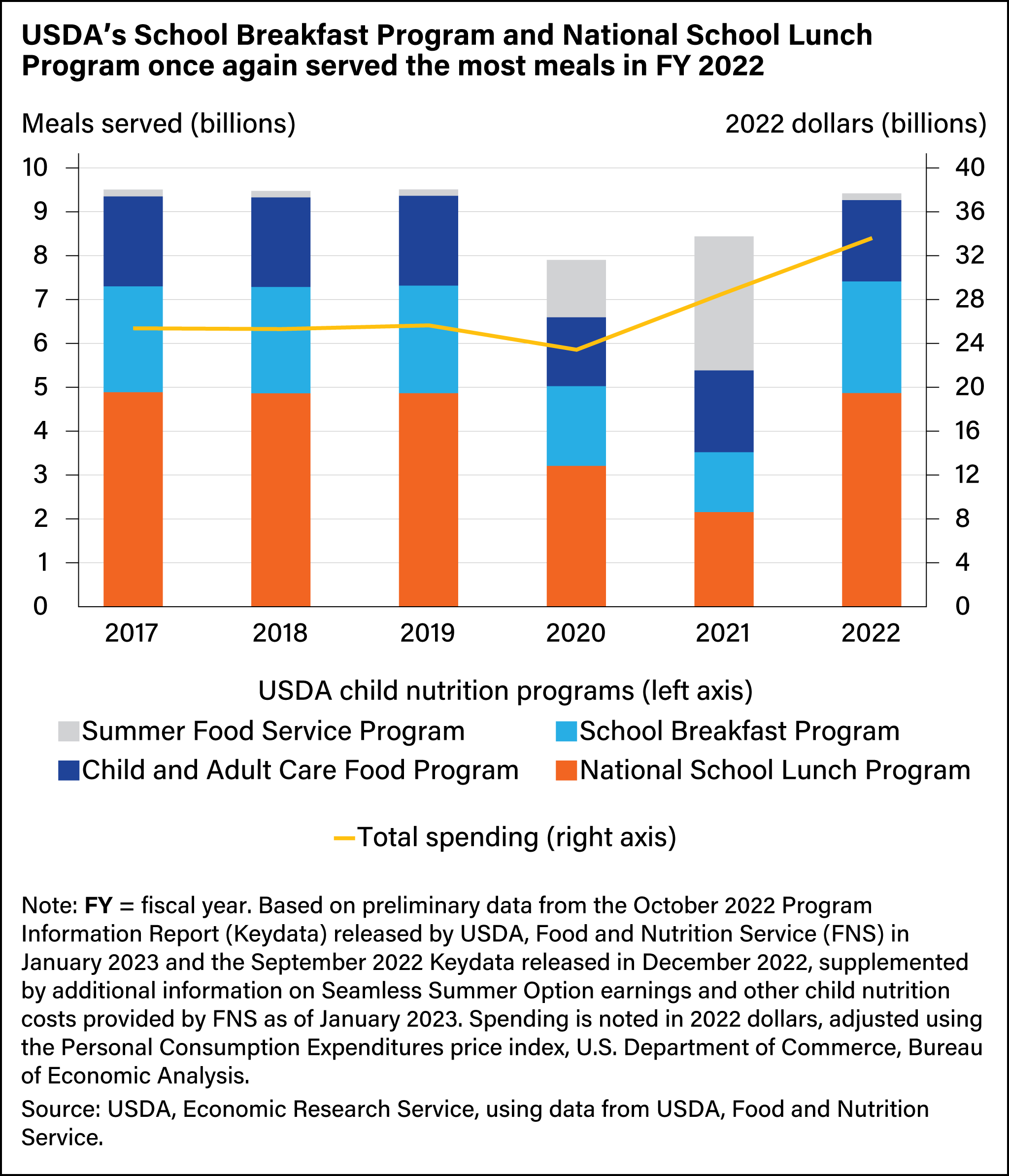
U.S. Food and Nutrition Assistance Programs Continued To Respond to Economic and Public Health Conditions in Fiscal Year 2022
- by Jordan W. Jones and Saied Toossi
- 8/21/2023
Highlights
- Economic conditions and other factors affect spending on USDA’s food and nutrition assistance programs by influencing the portion of the population that is eligible to participate, rates of participation, and benefit levels.
- In some ways, fiscal year (FY) 2022 marked a return to prepandemic operations for the largest food and nutrition assistance programs. However, new challenges also emerged, such as rising food inflation and infant formula shortages.
- Annual spending on food and nutrition assistance in FY 2022 fell to $183.0 billion from the record high total spending in FY 2021.
Economic conditions and other factors affect spending on USDA’s food and nutrition assistance programs by influencing the portion of the population that is eligible to participate, rates of participation, and benefit levels. Because these programs are means-tested, the portion of the population that is eligible to participate increases during economic downturns—when unemployment rates rise and incomes fall —as does the participation rate and the size of benefits for which participants are eligible. The Supplemental Nutrition Assistance Program (SNAP) provides low-income households with additional resources to buy food and reaches tens of millions of people each month. As one of the Nation’s primary countercyclical programs, SNAP expands during economic downturns and contracts during periods of growth. Historically, the SNAP participation rate tends to track the unemployment and poverty rates.
The Coronavirus (COVID-19) pandemic and related shutdowns, beginning in March 2020, disrupted businesses’ regular operations and contributed to an economic recession characterized by a spike in the unemployment rate from 4.4 percent in March 2020 to 14.7 percent in April 2020. Compared with previous downturns, the 2020 recession was short-lived, and by 2022, the unemployment rate had fallen to lower than it was in 2019. However, the pandemic disrupted daily life and the overall economy in many unique ways. For example, many parts of the United States implemented limitations on indoor gatherings to curtail the virus’ spread, and supply-chain disruptions affected industries across the economy. Additionally, food inflation grew modestly during the 2020 recession and then sharply increased in 2021. Annual food inflation reached 9.9 percent and overall inflation reached 8.0 percent in 2022, the highest annual increases in prices since the recessionary period of the early 1980s.
In response to the economic and public health conditions created by the pandemic, the Federal Government expanded USDA’s existing food and nutrition assistance programs and adjusted program operations to protect the health and safety of program participants and staff. In addition to SNAP, the largest food and nutrition assistance programs administered by USDA include the Special Supplemental Nutrition Program for Women, Infants, and Children (WIC), the National School Lunch Program (NSLP), the School Breakfast Program (SBP), and the Child and Adult Care Food Program (CACFP). WIC provides supplemental food packages and other support to pregnant and postpartum women as well as infants and children up to age 5 who are at nutritional risk and living in low-income households. USDA’s child nutrition programs, including the NSLP, SBP, and CACFP, provide nutritious meals and snacks at low or no cost to children in participating schools and childcare providers. Federal action in 2020 authorized USDA to create the Pandemic Electronic Benefit Transfer (P-EBT) program, which reimburses eligible families for the value of school meals their children missed because of the pandemic.
Annual USDA food and nutrition assistance spending rose during the pandemic, reaching a record high of $183.3 billion in fiscal year (FY) 2021. Adjusted to 2022 dollars, FY 2021 spending totaled $194.7 billion. Spending in FY 2022 fell to $183.0 billion, though this amount was still 38 percent above the prepandemic inflation-adjusted high in FY 2013.
Food and Nutrition Assistance Policy Developments in FY 2022
In response to the pandemic, Congress passed legislation throughout FY 2020 and 2021 that affected the operations of USDA’s food and nutrition assistance programs. Those bills included the Families First Coronavirus Response Act (FFCRA); the Coronavirus Aid, Relief, and Economic Security (CARES) Act; the Continuing Appropriations Act, 2021 and Other Extensions Act; the Consolidated Appropriations Act, 2021; and the American Rescue Plan Act (ARPA). During this period, USDA authorized increases in SNAP benefits and suspended work-related time limits on SNAP receipt for some adults. WIC appropriations were increased, and the WIC cash value voucher (CVV) benefit for fruits and vegetables was temporarily raised. USDA was given the authority to launch P-EBT and expand the size and scope of its summer meal programs targeting children. USDA relaxed several program requirements, allowing for greater flexibility in the operation of SNAP, WIC, and the child nutrition programs.
Food and nutrition assistance policy continued to develop in FY 2022 in response to the pandemic as well as new challenges, such as rising inflation and infant formula shortages. Major policy changes included changes in the amount of the WIC cash value voucher, as well as a permanent increase in the maximum SNAP benefit following the 2021 Thrifty Food Plan reevaluation. P-EBT was expanded to cover more children, and extra funding was allocated to support school meal programs. By the end of FY 2022, the temporary WIC cash value voucher benefit increases had expired (but were extended again in FY 2023), and the child nutrition programs returned to prepandemic Federal rules and guidelines.
SNAP Spending and Participation Down Slightly in FY 2022 after FY 2020–21 Increases
As a countercyclical program, SNAP participation tends to rise with increases in unemployment and poverty. However, decreases in participation can lag reductions in unemployment during the early stages of an economic recovery. Because SNAP is also an entitlement program, spending on benefits increases directly with participation.
Average monthly SNAP participation increased for a period after the start of the Great Recession in December 2007, as it did after the start of the short recession in February 2020 related to the COVID-19 pandemic. These periods of program growth, however, differ significantly from each other. The increase in participation after the Great Recession was much larger and longer lasting, reflecting the length and depth of that economic downturn. Participation increased for 6 consecutive years, from 26.3 million participants in FY 2007, before the recession, to 47.6 million in FY 2013. This represents an average increase of 13.5 percent per year. Adjusted for inflation to 2022 dollars, SNAP spending increased over this period from $44.5 billion in FY 2007 to $96.9 billion in FY 2013, an average 19.6 percent increase per year.
In contrast, the pandemic-related recession was concentrated over a shorter period. Accordingly, SNAP participation increased less overall and for a shorter period compared to the Great Recession. Participation increased from 35.7 million in FY 2019 to a peak of 41.6 million in FY 2021, an average 8.2 percent increase per year. Participation then fell slightly to 41.2 million in FY 2022. However, SNAP spending rose more quickly given the shorter time span. Adjusted for inflation to 2022 dollars, spending on SNAP rose from $67.5 billion in FY 2019 to $120.8 billion in FY 2021, an average increase of 39.5 percent per year. Spending fell in FY 2022 to $119.5 billion.
Why did SNAP spending increase more quickly after the pandemic’s onset, compared with the Great Recession, given the smaller increase in participation? The maximum allotment was increased during both periods but by different amounts: by 13.6 percent from April 2009 to November 2013, by 15 percent from January 2021 to September 2021, and by about 21 percent, permanently, beginning in October 2021. Additionally, emergency allotments were central to the spending growth during the pandemic. Emergency allotments were issued as monthly disaster supplements starting in March, April, or May 2020, depending on the State. These supplements brought all recipient households’ benefits to the maximum allowed each month and later provided a minimum $95 in extra benefits. In FY 2021, inflation-adjusted disaster supplements accounted for $39.2 billion, almost a third of total spending. Without disaster supplements, total spending would have been $81.6 billion in FY 2021, about $15 billion less than FY 2013 spending, adjusting for inflation. Emergency allotments were phased out in 17 States over FY 2021–22 and in the remaining States in January and February 2023.
Number of Meals Served Through Child Nutrition Programs Returns to Prepandemic Level
The Families First Coronavirus Response Act allowed USDA to issue nationwide waivers of child nutrition program requirements in response to pandemic disruptions to in-person education and childcare. One set of waivers expanded the scope and coverage of the Summer Food Service Program (SFSP) and the NSLP and SBP’s Seamless Summer Option (SSO). Typically, these programs allow qualifying organizations to provide free meals to children when schools are not in session in areas or sites where at least half of children live in households with income less than 185 percent of the Federal poverty level. USDA waived these requirements, allowing the provision of free meals in all areas, regardless of income, throughout the year.
One important difference between the SFSP and SSO is that meals served through the SFSP receive higher Federal reimbursements than those served through the SSO, which are reimbursed at the same rates as for the NSLP and SBP. As such, in FY 2021, most schools opted to serve meals through the SFSP, making it one of the largest child nutrition programs that year. This changed in July 2021, when USDA allowed SSO meals to be reimbursed at the higher SFSP rates. As a result, most meals were served through the NSLP and SBP’s Seamless Summer Option in FY 2022. The number of meals served through the Child and Adult Care Food Program (CACFP) in FY 2022 was about the same as in FY 2021 and FY 2019.
Most child nutrition program waivers—including the waiver allowing for higher reimbursements for SSO meals—expired at the end of June 2022. In anticipation of the waivers’ expiration, Congress passed the Keep Kids Fed Act in the same month. This legislation increased Federal reimbursements for NSLP, SBP, and CACFP meals and extended some of the waivers—such as the waiver allowing SFSP to operate in all areas—through September 2022.
The number of meals served through the NSLP, SBP, CACFP, and SFSP increased to 9.4 billion in FY 2022 from 8.4 billion in FY 2021 and 7.9 billion in FY 2020 and was about the same as the number served before the pandemic in FY 2019. The larger number of meals served, higher reimbursement rates for meals, and the fact that nearly all meals were served for free in FY 2022 translated to higher spending across all four programs. Total spending on the four programs rose to $33.6 billion in FY 2022 from $28.6 billion in FY 2021, adjusted for inflation.
WIC Program Challenged by Infant Formula Recall in FY 2022
State WIC agencies continued to use waivers in FY 2022 that allowed for flexibilities in WIC services during the pandemic. These waivers, first issued in FY 2020, allowed for alternative modes of service delivery (such as remote certification and recertification) and deferrals of medical documentation requirements for applicants. They also allowed for food package substitutions to accommodate supply chain disruptions that had led to shortages of some foods.
These disruptions intensified in February 2022 because of an infant formula recall prompted by evidence of a bacteria at a major infant formula manufacturer’s facility that may have been harmful to infants if present in formula and the subsequent shutdown of the facility. In response, USDA issued new waivers in FY 2022 that allowed WIC participants to exchange recalled formula, as well as to receive different brands (including certain imported formulas) of formula, forms of formula, and sizes of formula containers.
WIC’s cash value voucher (CVV), which provides a fixed dollar amount that can be used to buy a variety of fruits and vegetables, was also revised in FY 2022. In FY 2021, the American Rescue Plan Act gave States the option to increase the CVV benefit to a maximum of $35 per participant for up to 4 months through September 2021. Beginning in October 2022 and extended through the end of FY 2022, the voucher amounts were changed to $24 for children, $43 for pregnant or postpartum participants, and $47 for breastfeeding women. Federal spending on the program totaled $5.7 billion in FY 2022, higher than the $5.4 billion spent in FY 2021, adjusted for inflation. This reflects an increase in monthly WIC food package costs per person to $47.72, up 26 percent from FY 2021, adjusted for inflation.
Spending on Pandemic Electronic Benefit (P-EBT) Program Declined in FY 2022
The Families First Coronavirus Response Act also authorized USDA to create the temporary P-EBT program to reimburse eligible families for the value of school meals missed because of pandemic-related disruptions to school operations. States proposed plans to provide P-EBT benefits on different timelines, which USDA then approved. Some States issued benefits in a lump sum to cover an entire period of missed meals, and others issued multiple smaller payments.
The Federal Government expanded P-EBT several times in FY 2021 and FY 2022. In October 2020, P-EBT was expanded to include eligible children under age 6 and to operate in Puerto Rico, the Northern Mariana Islands, and American Samoa. In January 2021, the program’s benefits were increased about 15 percent to include the value of school snacks. In March 2021, the American Rescue Plan Act authorized the P-EBT program to cover the summer months and operate in any future school year with a COVID-19 public health emergency declaration in place. In September 2022, the program was expanded again to include eligible children who entered virtual academies or homeschooling because of the pandemic but who previously had attended an NSLP participating school. Spending on the program amounted to $17.9 billion in FY 2022, down 41 percent from $30.2 billion in FY 2021, adjusted for inflation.
U.S. Food and Nutrition Assistance Changes Continue in FY 2023
U.S. food and nutrition assistance programs continued to develop in FY 2023. The Consolidated Appropriations Act, 2023, ended SNAP emergency allotments after February 2023 benefits were issued. Emergency allotments were initially slated to expire one month after the expiration of the Federal public health emergency. The act also established a permanent Summer Electronic Benefit Transfer (Summer EBT) program, which would issue benefits redeemable for food to families with eligible children during the summer months when regular school meals are not available. P-EBT will end in September 2023. Several States adopted legislation providing free school meals to all students. USDA, Economic Research Service researchers will continue to track how these and other changes affect the domestic food and nutrition assistance landscape.
This article is drawn from:
- Toossi, S. & Jones, J.W. (2023). The Food and Nutrition Assistance Landscape: Fiscal Year 2022 Annual Report. U.S. Department of Agriculture, Economic Research Service. EIB-255.
You may also like:
- Hodges, L., Jones, J.W. & Toossi, S. (2021, October 4). Coronavirus (COVID-19) Pandemic Transformed the U.S. Federal Food and Nutrition Assistance Landscape . Amber Waves, U.S. Department of Agriculture, Economic Research Service.
- Food & Nutrition Assistance. (n.d.). U.S. Department of Agriculture, Economic Research Service.
- Toossi, S., Jones, J.W. & Hodges, L. (2022, September 6). Pandemic-Related Program Changes Continued to Shape the U.S. Food and Nutrition Assistance Landscape in Fiscal Year 2021. Amber Waves, U.S. Department of Agriculture, Economic Research Service.
- Jones, J.W., Toossi, S. & Hodges, L. (2022). The Food and Nutrition Assistance Landscape: Fiscal Year 2021 Annual Report. U.S. Department of Agriculture, Economic Research Service. EIB-237.
- Toossi, S., Jones, J.W. & Hodges, L. (2021). The Food and Nutrition Assistance Landscape: Fiscal Year 2020 Annual Report. U.S. Department of Agriculture, Economic Research Service. EIB-227.
- Toossi, S. (2023). Cost of School Meals and Households’ Difficulty Paying for Expenses: Evidence From the Household Pulse Survey. U.S. Department of Agriculture, Economic Research Service. EB-37.






